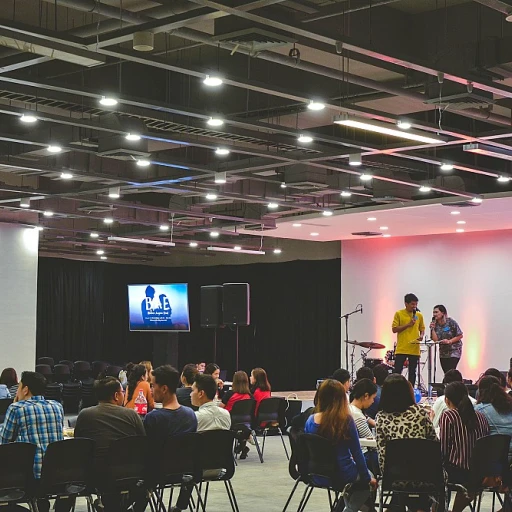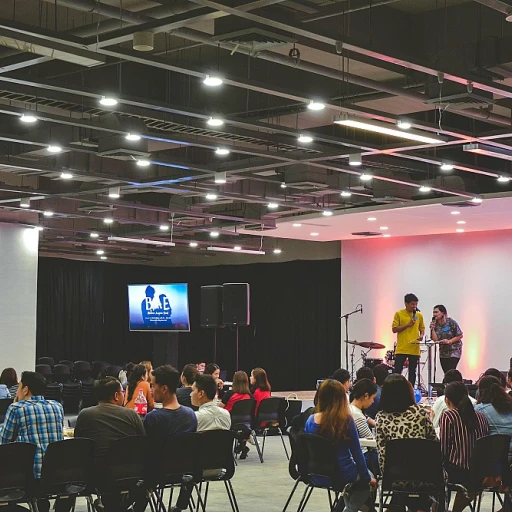
Understanding the Role of an Employee Engagement Committee
Examining the Crucial Role and Impact on Company Culture
When it comes to enhancing workplace culture, an employee engagement committee plays an instrumental role. The primary function of these committees is to foster a positive work environment by promoting initiatives that align with the organization’s goals and values. By actively promoting engagement efforts, these committees help create a setting where employees feel valued and appreciated. Engagement committees act as a bridge between employees and the organization, providing a platform for sharing feedback and suggestions. This helps ensure that the company culture is reflective of its workforce’s diverse perspectives. The presence of a committee not only enhances communication but also demonstrably boosts employee morale, fostering a team spirit and elevating work life balance. Furthermore, by instituting initiatives such as team building activities and recognition programs, engagement committees significantly contribute to employee satisfaction. These programs are crucial in building a robust workplace culture that is attractive to both current and potential employees, ultimately promoting a high-performance culture in modern workplaces. Whether it’s through feedback sessions, cultural events, or life enrichment programs, employee engagement committees play a pivotal role. Not only do they strive to enhance the work environment, but they also work towards embedding engagement strategies that help in retaining and attracting talent, ensuring a thriving organizational culture. For organizations aiming to cultivate a nurturing and inclusive atmosphere, expression through a structured engagement committee can be an effective strategy to drive change and improvement. Cultivating a High-Performance Culture in today's dynamic environments heavily relies on these collective efforts.Key Benefits of Implementing an Employee Engagement Committee
The Advantages of Establishing Engagement Committees
Introducing employee engagement committees within your workplace can serve as a strategic initiative to reinforce and elevate the company culture. These committees play a pivotal role in fostering a positive work environment, benefiting both the organization and its employees. By nurturing a workplace where individuals feel valued and recognized, committees contribute substantially to the overall culture and productivity.
Here are the key benefits of implementing engagement committees:
- Creating a Sense of Belonging: Engagement committees enable employees to connect, fostering a sense of belonging within the organization. This strong rapport paves the way for enhanced team building and collaboration.
- Boosting Employee Morale: By organizing various engagement activities and initiatives, these committees significantly boost employee morale. Employees feel more motivated and engaged when they perceive their efforts being appreciated and acknowledged.
- Enhancing Communication: These committees act as a valuable channel for open communication between management and staff. This ensures that employees' feedback and ideas are heard, contributing to improvement in strategies and work practices.
- Driving Innovation: With a platform to share diverse perspectives, employees are more likely to contribute innovative ideas. As a result, companies can harness this diversity of thought to achieve better engagement strategies and organizational goals.
- Improving Work-Life Balance: By emphasizing the importance of work-life balance through targeted programs and initiatives, engagement committees ensure that employees maintain a healthy balance between their professional and personal lives.
- Encouraging Recognition: Recognition programs often facilitated by engagement committees contribute to a more engaging and motivating work environment. Employees who feel valued are more likely to demonstrate loyalty and commitment to the company.
The implementation of engagement committees serves as a significant asset, not only in cultivating a strong workplace culture but also in advancing the organization's strategic goals. By aligning engagement efforts with company objectives, businesses can achieve a harmonious work environment that thrives on mutual respect and understanding.
Strategies for Forming an Effective Employee Engagement Committee
Formulate a Special Taskforce for Employee Engagement
Establishing a devoted team for fostering employee engagement within an organization involves strategic planning and thoughtful consideration. The formation of an engagement committee is a pivotal step in transforming workplace culture and ensuring employees feel valued and connected with the company's goals.
Identify Key Stakeholders
The first step is to identify key stakeholders who are passionate about enhancing the work environment. This team should include representatives from various departments to ensure a holistic view of the organization’s needs. Doing so allows for a diverse and inclusive range of perspectives, providing a comprehensive approach to committee employee activities and engagement initiatives. Additionally, empowering the right people facilitates a seamless integration of recognition programs and team building ideas.
Define the Committee’s Mission and Goals
Once your stakeholders are identified, it's vital to define clear objectives. A well-crafted mission statement sets the tone and direction for the engagement efforts. This involves establishing what the committee aims to accomplish and the strategies that it will implement. Outlining specific engagement strategies ensures clarity and alignment with the organization's broader vision. Consider referencing best practices to align strategic initiatives with desired outcomes.
Develop Effective Communication Channels
Seamless communication is essential for any committee. Regular meetings should be scheduled to discuss progress, gather feedback, and brainstorm new ideas. Establishing channels, such as emails, group chats, or dedicated software platforms, helps in maintaining continuous dialogue among committee members. This consistent communication aids in forming cohesive engagement programs that resonate with the entire organization.
Engage Employees Actively
To have engaged employees, it's crucial to involve them in the process. Solicit their input and suggestions on engagement initiatives via surveys or focus group discussions. This inclusive approach not only helps in generating creative ideas but also makes employees feel that their opinions matter, fostering a company culture of openness.
Assign Roles and Responsibilities
Clarity on roles within the engagement committee is imperative. Each member needs to understand their specific responsibilities to contribute effectively toward work life balance and promoting a positive culture at the workplace. Assign roles based on individual strengths and interests to maximize engagement and productivity.
Explore New Engagement Ideas
As part of your efforts to enhance engagement, contemplating innovative ways to engage employees can be incredibly beneficial. Keeping the engagement practices fresh and interesting can stimulate continuous improvement and invigorate the team dynamics.
Innovative Ideas for Employee Engagement Initiatives
Revamping Employee Engagement with Creative Approaches
Initiating innovative ideas for employee engagement can significantly enhance workplace culture and ensure a motivated workforce. Engaged employees are vital for any organization, as they contribute to a thriving work environment and a positive company culture. Here are some innovative approaches an employee engagement committee can consider:- Team Building Activities: Organizing team building events can help foster camaraderie among employees. Initiatives like office Olympics, escape rooms, or even simple ice-breaking activities during meetings can enhance the dynamics within teams and improve collaboration.
- Work-Life Balance Programs: A committee can design programs that promote a healthy work-life balance. Flexible work hours, remote work options, and wellness days can make employees feel valued and respected, thereby boosting their engagement.
- Employee Recognition Programs: Recognizing employees' efforts and achievements not only boosts morale but also helps in building a culture of appreciation. Committees could establish monthly or quarterly recognition programs that celebrate employee contributions.
- Feedback Loop Systems: Implementing feedback mechanisms allows employees to voice their opinions and be part of the decision-making process. Regular surveys or focus groups can provide valuable insights and help the committee adjust its engagement strategies accordingly.
- Learning and Development Opportunities: Organizing workshops, seminars, or mentorship programs can foster professional growth and satisfaction among employees. This ensures that employees feel their personal and career goals are supported by the company.
Measuring the Impact of Employee Engagement Committees
Assessing the Outcomes of Employee Engagement Initiatives
Understanding the impact of employee engagement committees is crucial for ensuring that their initiatives yield the desired results in enhancing workplace culture. By evaluating the effects of these initiatives, organizations can better tailor future efforts to align with company goals and improve employee satisfaction. One of the most effective methods to assess the impact is through regular feedback from employees. By creating anonymous surveys, committee members can gain valuable insights into how employees perceive the engagement activities, recognition programs, and overall work environment. These surveys help in identifying both strengths and areas for improvement, creating a loop where feedback continuously refines employee engagement strategies. Moreover, monitoring key performance indicators (KPIs) linked to engagement can also be instrumental. This may include metrics such as employee turnover rates, retention levels, employee satisfaction scores, and productivity measures. These KPIs provide a quantitative measure of the impact that engagement committees have on workplace culture and can help validate the effectiveness of specific programs. In some cases, focus groups consisting of committee members and diverse employees can offer a qualitative depth of understanding. These discussions allow for open dialogue, where employees feel valued and heard, providing richer insights that numbers alone may not reveal. Such initiatives not only gather data but also reinforce the committee's commitment to fostering a positive culture. All in all, the success of an engagement committee depends significantly on its ability to continually measure and adjust its approach based on the changing needs of the workforce. As workplace culture evolves, engagement efforts should be flexible and dynamic, keeping employees engaged and contributing to a thriving organization.Overcoming Challenges in Employee Engagement Committees
Addressing Common Engagement Hurdles
One of the key challenges in overseeing employee engagement committees is managing diverse expectations and ensuring a unified approach to fostering a positive workplace culture. Committee members may have varying ideas or priorities, so aligning them with the overall goals of the organization is crucial. Regular communication and feedback sessions can help maintain this alignment and ensure that the committee's efforts resonate across the company.
Balancing Engagement with Workload
Another frequent challenge is promoting employee engagement without overwhelming team members with additional responsibilities. Maintaining a healthy work-life balance is essential, so it’s important to create initiatives that engaged employees find enjoyable yet manageable. Consider implementing flexible participation options or rotating committee functions to distribute the load evenly. This way, employees feel valued and can contribute positively without compromising their primary job responsibilities.
Inclusivity and Representation
Ensuring that the committee is inclusive and representative of the larger workforce is vital for successful engagement strategies. By involving employees from various departments and levels, the committee can gather comprehensive insights into what initiatives will most benefit the organization. This diversity in representation helps develop a culture where every voice is heard and valued, enhancing the overall work environment.
Continuous Improvement and Adaptation
Employee engagement efforts must be dynamic and evolve with changing workplace culture demands. Regularly measuring the impact of engagement initiatives through surveys and performance metrics helps to identify areas of improvement. Use these insights to refine strategies and adapt to emerging challenges. Successful engagement committees are those that consider engagement a core component of the company's growth and adaptability.













